
views
X
Trustworthy Source
Virginia Cooperation Extension
Publications and Educational resources from Virginia Tech and Virginia State University
Go to source
Determining the Type and Purpose of Your Hatchery

Determine the purpose of your hatchery. There are all sorts of different types of hatcheries that raise different types of fish for different purposes. In order to move forward on your intention to start a hatchery, there are some determinations you need to know up front. Most simply, know what type of fish you will raise – and why – in order to start setting up your hatchery or writing a business plan. In particular, consider the following, and have concrete answers to each before moving forward. What are you going to do with all the fish? Will you raise fish destined to be food, pets, or simply pond ornaments? Do you intend to take the backyard approach and build a custom fishing hole for you and your friends, or are you looking to build a business empire based on the for-profit production of the finest fish on the global market?

Decide what specific type of fish you want to raise. The type of fish you raise will be determined in part by the type of hatchery you hope to start. While the system you hope to build may influence your decision about what fish you will raise, there are several factors to consider about your options regarding the fish themselves. Once you’re leaning towards a certain type of fish, contact hatcheries that raise that type to see about the viability of going through with stocking your hatchery. Recognize that the costs associated with raising different types of fish will vary widely, for all sorts of reasons – including the amount of management different species require and the cost of the food they eat. Also consider the climate in which you will be operating your hatchery. Certain fish need certain temperature water to live in. If possible, you may want to avoid costs associated with heating or cooling water, which can be substantial.
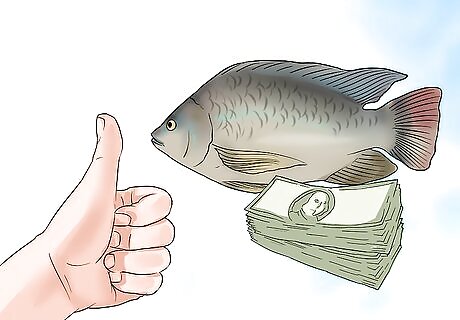
Take the easy route with Tilapia. Tilapia are some of the easiest fish to raise, and are eaten around the world. As such, they are among the most profitable types of fish to raise. They are hardy enough to tolerate different water conditions, including low oxygen and high ammonia, and are even more resistant to illness than many other fish. Tilapia need to be raised in water as close as possible to 84 degrees Fahrenheit (29 degrees Celsius). They will survive in water from 64-90 F (18-32 C), but will die if the water drops to 50 degrees. While there are many different types of tilapia, Bava, Blue, and Nile tilapia are the most appropriate for backyard and commercial hatcheries.
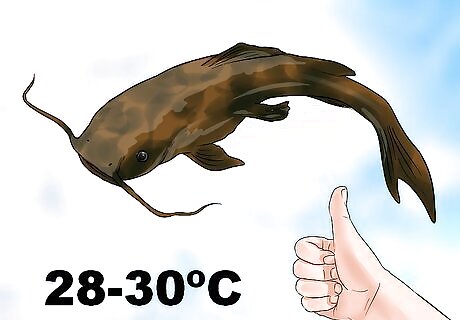
Catch yourself a catfish hatchery. Catfish are increasingly popular in people’s cuisine, and they’re some of the tougher fish there are in terms of resistance to disease and parasites. They also grow quite quickly. Channel catfish are one of the most popular – and profitable – choices for backyard farming, and there are several types to choose from. Recommended water temperatures for raising catfish vary based on the season and age of the fish. A such, catfish are commonly raised in outdoor ponds. Specifically, channel catfish fingerlings need to be stocked when water temperatures are between 65-68 degrees Fahrenheit (18-20 C). As catfish, they will grow more quickly in water between 83-86 degrees Fahrenheit (28-30 C).

Build a bass hatchery. Bass is unique in that many people actually prefer the taste of farmed bass to wild bass. Raising bass is most feasible in larger, well-circulated systems. Bass fingerlings, however, are more sensitive than many other young fish, and require strict nutritional supply, gentle handling, and even particular amounts of light. Raising bass may require extra holding tanks, as different sized individuals need to be stored separately. Bass prefer water as close as possible to 80 degrees Fahrenheit (27 degrees Celsius), but can survive in water ranging from 65-85 F (18-29 C).
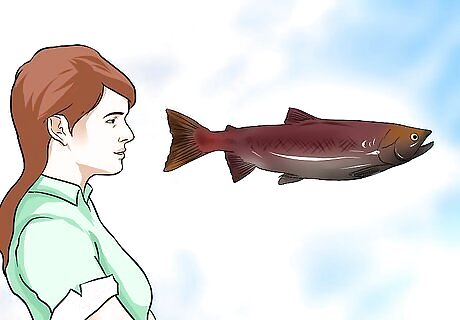
Consider raising trout, salmon, or perch. Trout and salmon are especially popular for human consumption, but they require more specific conditions than the other fish mentioned in this article. When raised at sustainable, well-run operations, these types of fish can be reliably profitable options. Yellow perch is popular in some markets too, though perch does not have the global popularity of trout and salmon. All three can grow to harvestable size in only one season. Trout and salmon can be raised together, providing some variety in your production. Keep water in which you’re raising trout and salmon between 55 and 60 F (13-16 C). If you’re only raising trout, water can be a bit warmer, but monitor oxygen levels more closely. Rainbow and brook trout are particularly popular, as are coho and Atlantic salmon.

Get the necessary permits and licensing. Before beginning construction of a hatchery of any size or type, account for the law in your area. There are lots and lots of laws about raising animals, and even more about raising animals to be consumed as food. Further, the ways in which your hatchery may effect the surrounding land or water need to be addressed before you move forward with starting a hatchery. Depending on the type, size, and location of your hatchery, the paperwork will vary – but count on there being a lot of it. If planning to operate a production hatchery, you’ll need to get a business license as well. Then there’s the whole other side of the law – and a whole new stack of paperwork.
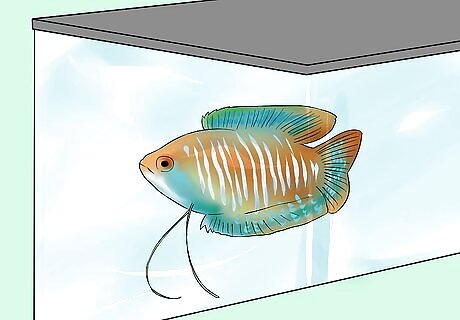
Grow a niche type of pet fish. One option for a hatchery that doesn’t take up a lot of space is raising an aquarium fish for the fish-as-pet-or-decoration market. Rare types of fish that are popular amongst those who keep aquariums are usually not raised on high production equipment, and can be hatched indoors in a few small tanks and with far less equipment than needed for larger hatcheries. Angelfish, for instance, can easily be raised on equipment that you can get altogether in a ready-to-use set. For different types of fish, you’ll need different types of specific filters, tanks, and water-treating equipment, and fish food. For small aquariums, however, most of these will be available at specialty pet stores. Choose a breed of fish – such as angelfish – that are already commonly sold in pet stores, so you know you’ll have demand for the glittery critters as soon as they’re ready to find a home of their own.
Developing a Business Plan for a Production Fishery
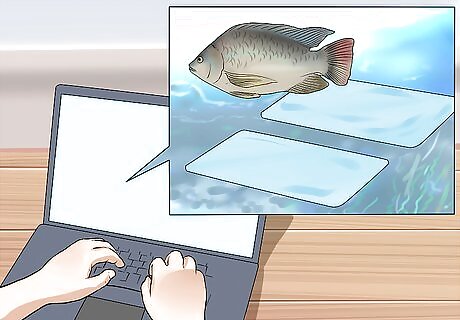
Educate yourself about fish hatcheries. If you’re not familiar with the industry, you’ll need to acquire some first-hand experience before starting your own hatchery. Even if you do have some experience, owning and operating a hatchery of your own will require substantial knowledge of your specific operation and of the industry in general. If you only intend to own and oversee the business side of a hatchery, you still need to know enough to make business decisions and hire competent personnel to run your business. Work at a running hatchery that’s as similar as possible to the sort of hatchery you envision opening. Consult online resources and print publications, many of which are specific to certain styles of hatcheries or to raising certain types of fish. Take courses on fishery operations at a university or trade school. This is a good idea early on, as the broad, supplemental knowledge provided by a classroom course will help you make decisions about the type of hatchery you’d like to start.

Make a business plan. A solid business plan will be vital to acquire any necessary investment capital. Aside from a fair amount of commercial equipment, you’ll also need the capital to get the business running and to pay employees to help you keep it running. Aside from luring investors, you’ll need a business plan to help meet potential business partners, and to get loans. Include a clear and specific feasibility report in your business plan. This should include thorough calculations of your initial expenses, operating costs, and anticipated profits for the first few years of business. Know that the anticipated costs of starting a hatchery depends entirely on the type of hatchery you wish to start. Though small backyard setup may cost as little as a few hundred dollars, a production facility will require thousands of dollars of investment in equipment alone.

Focus on the financial considerations. The capital and operating costs of starting a business – especially a production business – can wind up being far more than expected. Prepare yourself fully to have accurate expectations and to acquire a sufficient amount of initial capital. Carefully weigh both general and specific considerations, and don’t forget to consider important factors aside from the specifics of the hatchery itself. Ensure that there is sufficient demand in the market to meet the level of sales you need to be successful financially. Consider whether a hatchery is the best possible use of the specific real estate and capital you intend to use. Reflect honestly on whether you personally have the time and financial security to start a new business.
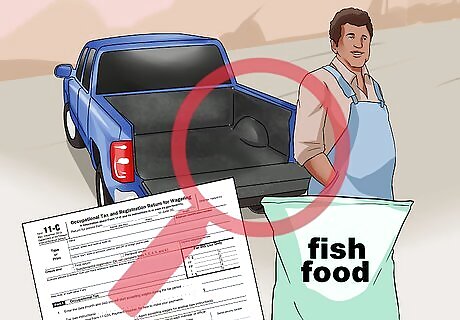
Forecast operating costs by having specific numbers ready for potential investors. Be ready to quote the anticipated costs of stocking your hatchery initially, fish food, electricity and other power, labor, water treatment chemicals, insurance, taxes, and extraneous things like maintenance and transportation. Knowing as much as possible will ensure you make accurate estimates of both initial startup costs and operating costs. Unforeseen costs can greatly hinder a new company, and the best way to prevent them is by knowing you’ve thought of everything.
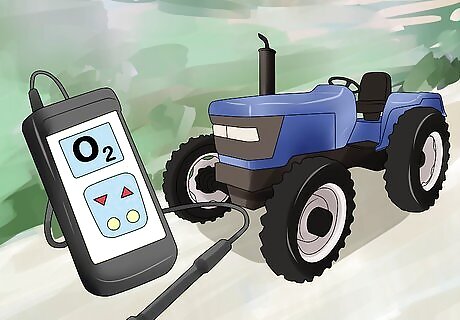
Ensure you've considered all construction and equipment expenses. Make sure you’ve considered potentially expensive necessities in particular. For instance, even if you already have the land, think about what needs to be done to it. Will anything need to be dug or built? Further, what will hold the fish? All costs need to be accounted for – down to the safety equipment your staff will wear. In a large scale production you’ll need a tractor, ample storage space, and maybe even trucks. Have you accounted for all the piping that will connect tanks and ponds and water equipment? What about oxygen meters and other testing supplies?

Develop a specific marketing strategy. Though raising fish may not seem like a business endeavor that requires advertising, a marketing plan will greatly help get your business up and running. If there is an established market, how are you going to break into it? Will demand be consistent year-round? Consider where will be ideal for focused sales efforts.

Round out your business plan with a healthy dose of risk assessment. Though unpleasant to think about, you have to account for the potential risks inherent to your business. One classic consideration is whether you could survive if you lost an entire crop of fish. You’ll need the investment necessary to be able to do so, as losing an entire crop is a realistic possibility. Develop a plan for a backup water source if your current source drops below an allowable quality threshold. Assess and address the risk for contamination by pesticides, metal, or anything else at the location in mind. Develop and maintain contacts for advice and information, even before you need it - particularly in terms of fish health.
Farming Fish in your Backyard

Dig your own pond. A small pond is one of the cheapest and easiest ways to start a small fish hatchery, for either personal use or local sales. Still, it will likely cost at least a few thousand dollars to get a pond-based hatchery up and running. Further, the size of your pond and the climate where you live will determine which fish will be most viable for you to raise. Municipal water is often okay to fill an artificial pond, though pumping water from a natural body of water near your home may be preferable. Make sure that you are not violating any laws or regulations by manipulating any natural bodies of water or watersheds by checking with your local fish, wildlife and environmental regulatory agencies. In areas where ponds may freeze, you can pump and cycle water through an artificial heater to keep the pond warm and liquid-enough for fish to survive in. Cold climates, however, will substantially increase the cost of operation and the risk involved in running your hatchery.
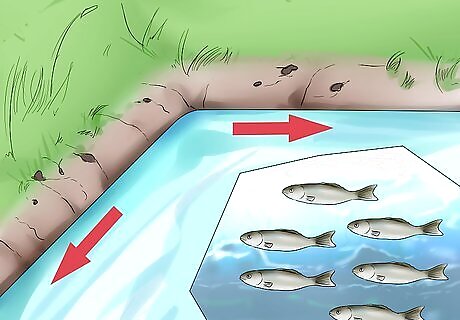
Stock the pond according to its size. When stocking your pond with fingerlings, use the capacity of your pond to determine the number of fish it can safely hold. Depending on the type of fish you choose to raise, maintain the pond at a certain size and depth. Take extreme care not to overcrowd the pond, as water quality and fish health can rapidly deteriorate in an overcrowded body of water.
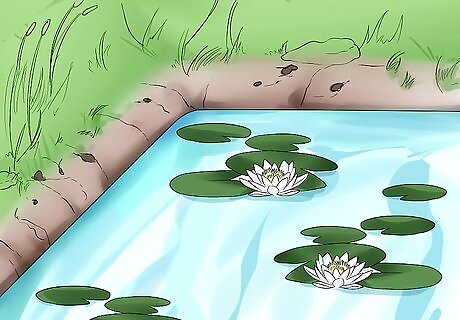
Balance your pond to minimize the need for management. Aquatic plants are very helpful for multiple reasons. In an immediate sense, they provide cover for your fish during the day. Furthermore, plants help keep a pond ecologically balanced and will make a small pond a fish-raising haven with very little effort on your part. Determine the types of plants to include in your pond based on the type of fish you plan to raise, as well the types of plants that grow naturally in ponds in your area.
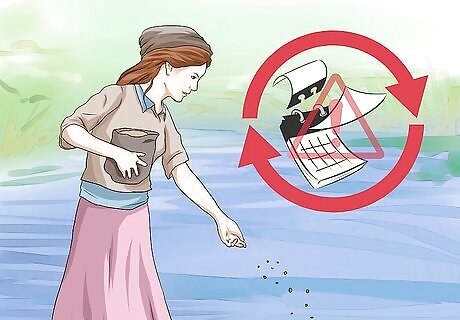
Feed your pond fish depending on several factors. Another benefit of backyard pond hatcheries is that you can likely feed your fish less often, since your fish will be able to eat plants and insects. Even for rapid growth and a quick harvest, you’ll only have to feed your fish once in a while. Be careful not to over-feed your fish, as this may contribute to illnesses, more bacteria in the water, and decreased water quality overall. To determine whether your fish are in need of more food, observe their behavior when you add food to the water. If the fish go into a frenzy and eat all the food extremely quickly, start to feed them slightly more regularly.
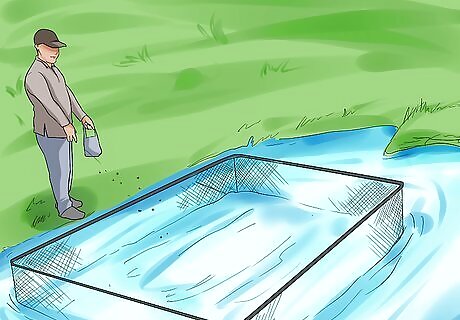
Farm fish via cage culturing. If there is already a body of water present on land you have access to, you can likely set up a small fish hatchery with readily available materials. For instance, a cage can be built with plastic piping and netting, and then anchored to the edge of a body of water and used to culture fish. Make sure the water you have access to is suitable for raising fish before deciding to start a hatchery in a natural body of water. Stock the cage with fingerlings and simply feed them until they are large enough to harvest. For a small cage culture, expect to pay for only cage materials, fingerlings, and food – which may cost as little as $100 altogether.
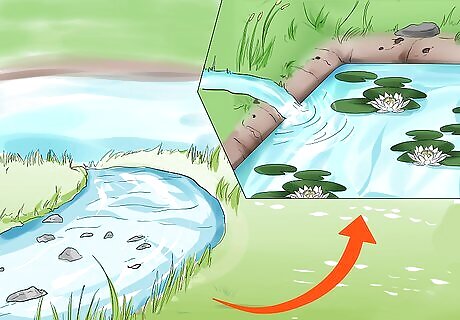
Build a flow-through hatchery. Divert a continuous source of cold water, such as a natural stream or river, into corridors that can contain fish while allowing them to swim in flowing water. You will likely need less water than you think – but the flow must remain constant. In the right location, flow-through hatcheries can be a relatively simple way to raise fish. Be aware of additional regulations involved with diverting and benefiting from the use of natural resources. Contact local conservation authorities to discuss your plans. This is the method used to help many government-run conservation efforts. However, this method is harder to set up than many other options, is often not allowed, and is not as commercially viable as other options.
Starting a Commercial Hatchery
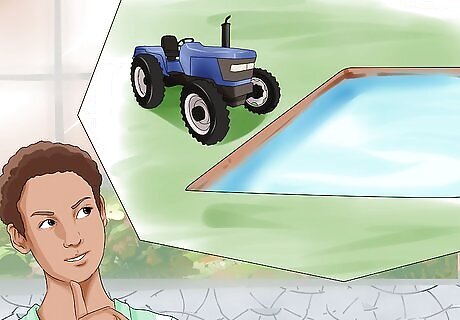
Scale up a pond-based hatchery. For larger-scale pond-based hatcheries, you will need several ponds, a good amount of land, and a substantial amount of additional equipment. Conceptualize scaling up a pond-based hatchery as the equivalent endeavor of going from having a garden to having a commercial farm – it will require a huge amount of planning, time and investment.
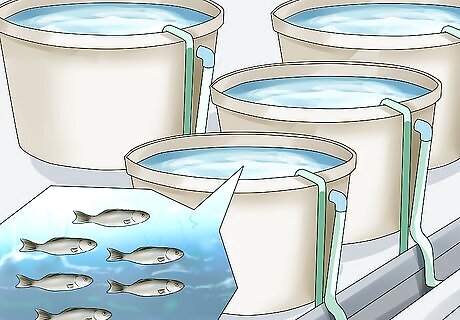
Raise fish in tanks, containers, or tubs. One of the limitations of ponds is the amount to literal space they take up. While ponds offer a great method of raising fish in limited quantities, container-based fish hatcheries can handle a higher production capacity within a relatively limited amount of space. Municipal water supplies are usually fine to fill tanks, though the water will likely need to be treated. Know that aquaponics systems come with far larger start-ups costs, a greater need for supplies and equipment, and a greater knowledge of commercial fish farming.
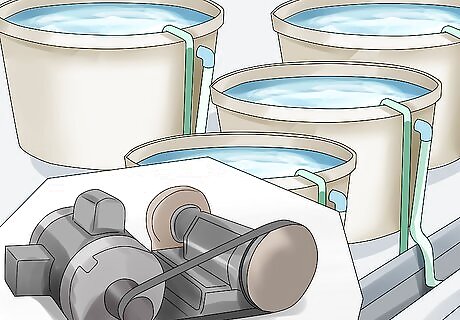
Install a pump and aeration equipment. Whatever the type of hatchery you intend to run – and especially for an aquaponics production hatchery – you’ll need a pump to help you ensure that your fish always have sufficient fresh water. Similarly, the water in which your fish live will likely require a steady influx of oxygen provided by aeration equipment. Pumps are also often necessary to cycle water from holding tanks to recycling pools or equipment that can clean the water and remove impurities. The more fish you’re trying to raise, especially in an indoor hatchery, the more water cleaning and aeration equipment you’ll need.
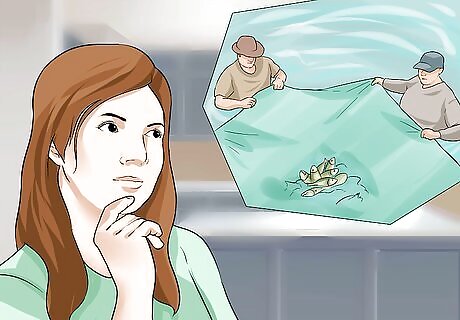
Figure out how you’ll capture, handle, and grade your fish. For production fisheries, you’ll need lots of equipment to deal with your product. In industry terms, you’re going to need a seine. Seines are used to harvest fish, or collect them from the water. As you harvest the fish, you’ll need to sort them by size. You’ll also need a way to handle the fish and potentially a way to transport fish to buyers. For larger scale hatcheries, you’ll need reels and other equipment that can be used to drag large nets. You’ll likely need a tractor and hoists to handle nets full of fish. As fish are graded, they will need to be moved to different holding tanks. You can also use counting equipment to keep track of your crop.


















Comments
0 comment